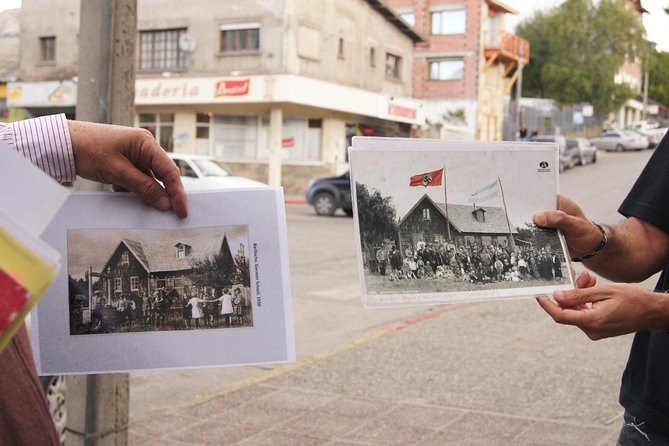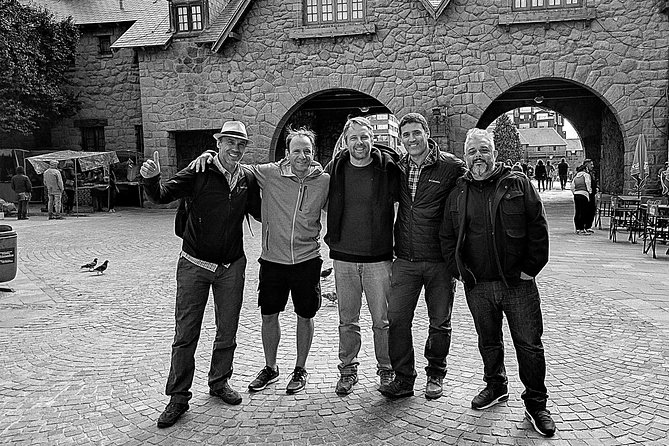As the morning sun casts a golden glow on the cobblestone streets of Bariloche, one cannot help but feel a sense of intrigue lingering in the air.
It is here, nestled amidst the majestic Andes Mountains and glistening lakes, that a captivating tale unfolds. A tale of German immigrants who left an indelible mark on this charming city, shaping its architecture, cuisine, and cultural fabric.
But beyond the beauty lies a darker chapter in Bariloche’s history – a chapter that speaks of a clandestine Nazi presence that sought refuge in these very hills.
With each step on this walking tour, the secrets of Bariloche’s German footprint and the haunting specter of the Nazi past are unveiled, leaving visitors with a profound understanding of the city’s complex heritage.
This experience made our list of the 2 Best Walking Tours In Bariloche.
Good To Know
- German immigrants played a significant role in shaping the local culture and economy of Bariloche.
- Bariloche has a strong German influence, evident in its architecture, cuisine, and cultural events.
- After World War II, Bariloche became a safe haven for some high-ranking Nazis and Nazi sympathizers.
- There are several historical sites and landmarks in Bariloche that showcase the German influence and Nazi presence in the city.
Tour Details and Highlights

The walking tour in Bariloche offers an immersive experience, allowing participants to explore the city’s fascinating history, including the German influence and Nazi presence that have shaped its culture and landmarks.
This tour lasts approximately 1 hour and 30 minutes, giving visitors ample time to explore the rich heritage of Bariloche.
The meeting point for the tour is Libertad 51, located in the heart of San Carlos de Bariloche. From there, the certified expert tour guide will lead the group through the city center, sharing captivating stories and insights along the way.
Participants will have the opportunity to learn about the German immigration to Bariloche in the late 19th century and the significant role they played in shaping the local culture and economy.
The tour also sheds light on the Nazi presence in Bariloche after World War II, making it a truly unique and informative experience for all.
Interested in exploring Bariloche on foot? Other walking tours we've covered
German Immigration to Bariloche

Attracted by the region’s natural beauty and agricultural opportunities, German immigrants arrived in Bariloche in the late 19th century. They played a significant role in shaping the local culture and economy, leaving behind a lasting impact. Today, the German community in Bariloche is still active, and many German traditions and customs are preserved in the area. To evoke an emotional response in the audience, let’s take a look at the impact of German immigration and the preservation of German culture in Bariloche through a table:
| Impact of German Immigration | Preservation of German Culture |
|---|---|
| Shaped local culture | German architecture |
| Contributed to the economy | German cuisine |
| Active German community | German-style beer |
| Preserved traditions | German language and events |
| German School of Bariloche |
The table showcases the positive influence of German immigration, highlighting how the community’s presence has enhanced the cultural fabric of Bariloche. German architecture, cuisine, language, and traditions have all become an integral part of the city’s identity.
German Footprint in Bariloche
With their arrival in Bariloche, German immigrants left a lasting imprint on the city, evident in the architecture, cuisine, and cultural events that continue to thrive today.
German cultural preservation is a significant aspect of Bariloche’s identity. The influence of German architecture can be seen in buildings throughout the city, with their distinctive style and craftsmanship. German cuisine has also made its mark, with local restaurants and bakeries offering traditional German dishes and delicacies. Bariloche is also known for its German-style beer, produced in the city’s breweries.
The German language and cultural events are organized regularly, providing opportunities for locals and visitors alike to experience and celebrate German traditions. The German School of Bariloche plays a crucial role in preserving the German language and heritage, providing education in both German and Spanish.
Thanks to the impact of German immigrants, Bariloche has become a vibrant hub of German culture in Argentina.
Nazi Presence in Bariloche
Nazi sympathizers and collaborators found refuge in Bariloche, Argentina, after World War II, turning the city into a haven for war criminals escaping justice. The presence of Nazis in Bariloche was supported by local authorities, allowing them to evade prosecution for their heinous crimes.
The covert nature of their arrival and the support they received made it difficult for investigators to uncover the extent of the Nazi presence. However, efforts to bring Nazi criminals to trial continue to this day. The investigations into the Nazi presence in Bariloche aim to shed light on the extent of their influence and ensure that justice is served.
Historical Sites and Landmarks
The historical sites and landmarks in Bariloche offer a fascinating glimpse into the city’s rich cultural heritage and architectural influences. These sites showcase the German architectural influence and the preservation of German traditions in the area.
The Old Town Hall, built by German immigrants, has been transformed into a historical museum. It stands as a testament to the German community’s contributions and their architectural style.
The Inalco House, once owned by a German family, is a prime example of German influence. Its design and décor reflect the cultural heritage of the German immigrants who settled in Bariloche.
The Civic Center, with its German-inspired architecture, is a must-visit site. Its buildings feature intricate details and designs that pay homage to the German architectural style.
These historical sites and landmarks not only offer a glimpse into the past but also highlight the lasting impact of German immigrants on the city’s architecture and cultural traditions.
- From Bariloche to San Martín De Los Andes via the 7 Lakes Route
- Trekking Day in the Mountains Close to Bariloche
- Tronador Hill Day Trip From Bariloche
- San Martin De Los Andes and the Seven Lakes Day Trip From Bariloche
- Half a Day of Kayaking on Lake Moreno in Private Service
- German Footprint & Nazi Presence – Walking Tour in Bariloche
Common Questions
What Is the Cost of the ‘German Footprint & Nazi Presence – Walking Tour in Bariloche’?
The cost of the tour is $29.00, and it offers language options in English and one more language. Participants can explore the German footprint and Nazi presence in Bariloche while learning about the city’s history.
Are There Any Age Restrictions for Participating in the Walking Tour?
There are no age restrictions for participating in the walking tour. The tour duration is 3 hours and it offers a fascinating exploration of the German influence and Nazi presence in Bariloche.
Can I Book the Tour in a Language Other Than English?
Yes, the tour can be booked in a language other than English. Language preferences for the tour include English and another language. Booking options are available to accommodate different language needs and preferences.
Are There Any Additional Fees or Expenses Not Included in the Tour Price?
Yes, there may be additional fees and expenses not included in the tour price. It is important to check the tour details and terms and conditions for any potential extra costs before booking.
Is the Tour Suitable for Individuals With Mobility Limitations?
The tour provides accessibility options for travelers with mobility limitations in Bariloche. Besides the Nazi presence, it offers a deeper understanding of the historical significance of Bariloche’s German heritage, including architecture, cuisine, and cultural events.
The Sum Up
To sum it up, a walking tour of Bariloche offers a fascinating glimpse into the German footprint and Nazi presence in this picturesque city. From the architectural influences to the cuisine and cultural events, the German immigrants have left a lasting impact.
However, it’s important to acknowledge the darker side of Bariloche’s history, with the refuge of high-ranking Nazis and ongoing efforts to bring them to justice. Exploring these historical aspects adds depth and understanding to the unique heritage of Bariloche.
More Walking Tours in Bariloche
More Tours in Bariloche
More Tour Reviews in Bariloche
Looking for something different? Other Bariloche activities we've written about
- 5 Best Guided Tours In Bariloche
- 3 Best Workshops And Classes In Bariloche
- 3 Best 4 Day Tours In Bariloche
- 12 Best Canoe And Kayak Experiences In Bariloche
- 16 Best Airport Transfers In Bariloche
- 20 Best Private Driver Services In Bariloche
- 17 Best Full-Day Tours In Bariloche
- 7 Best Boat Tours And Cruises In Bariloche
- 3 Best Fishing Tours In Bariloche
- 2 Best Walking Tours In Bariloche
- 2 Best Wine Tours In Bariloche
- 2 Best Bike Tours In Bariloche
